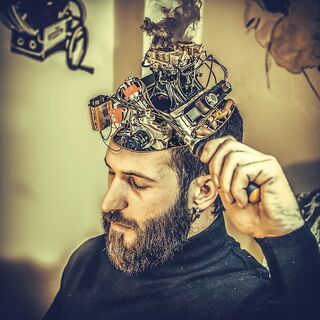Eating Disorders
Exploring the "Black Box" of Eating Disorders
The challenges we face in eating disorders neuroscience.
Posted May 14, 2021 Reviewed by Devon Frye
Key points
- Clinicians and neuroscientists approach eating disorders research differently.
- Eating disorders are heterogeneous illnesses, which makes brain-behavior conclusions difficult.
- Methodological limitations interfere with us connecting the psychological with the biological in eating disorders research.
- Justifying eating disorders as medical illnesses can influence policies, health decisions, and public perception.
“I used to throw up all the time in high school. Weight is still a struggle. Every video I’m in, every magazine cover, they stretch you—they make you perfect… it’s not real life.”
—Lady Gaga5
Americans are exposed to an average of 7,000 advertisements daily,3 with thousands of these being weight loss- and diet-related.4 Likewise, 90 percent of adolescents and young adults actively engage with social media “influencers” regularly.6 This exposure to diet culture and thin idealization could explain increases in body dissatisfaction over the past few years.
However, it doesn’t explain why only certain people develop eating disorders.
Looking for Answers
I initially chose to research media effects to understand environmental influences on eating behavior. However, while these studies have been enlightening, my initial questions about eating disorders remain unanswered. I still don’t know why some people develop these illnesses and others don’t.
It seemed to me that the only way to get answers to my questions was to open the “black box"—a term psychologists use for the brain—and look around.

So, I started studying neuroscience.
What I didn’t realize at the time was that I was falling into one of psychology’s most complex disorders… with a limited science background. My foray into neuroscience has been a rewarding, but challenging, adventure that I’m excited to share with you. However, before we dive in, I think I should explain the challenges we face when exploring the “black box” of eating disorders.
What Makes Researching the Neuroscience of Eating Disorders Complex?
One problem we have when doing multidisciplinary eating disorders research is that neuroscientists and clinicians approach it differently. In clinical research, the focus is on syndromes (a collection of symptoms that make up a disorder), while in neuroscience, the focus is on connections between the brain and cognition and behavior.2 So, a clinician might study anxiety in people diagnosed with an eating disorder, whereas a neuroscientist would study what brain mechanisms contribute to anxiety.
Because eating disorder categorizations are based on symptom clusters, there is a lot of variation within each classification. This makes it difficult to combine clinical and neuroscience research, as too much participant variation impedes our conclusions about brain-behavior relationships.
Simply put: Two people with the same eating disorder diagnosis might not have the same diagnostic or neural profile.
Another problem is the overlap between eating disorder categories and between categories of eating disorders and other psychological disorders. To alleviate this, the National Institute of Mental Health created a neuroscience-oriented framework for studying psychological disorders (RDoC).1 This framework uses different levels of analysis (i.e., cellular; neurocircuitry) to explore different domains related to behavior (i.e., negative valence; reward). However, few eating disorders researchers have used it.
Researchers studying the neuroscience of eating disorders also encounter brain analysis limitations. Because most eating disorders aren’t fatal, and the population experiencing them is relatively young, human brain samples for eating disorders studies are scarce. This means that neuroscientists rarely analyze the physical brains of individuals diagnosed with an eating disorder. Rather, they rely on blood and other bodily fluids to gain inference about brain functions and eating disorders behavior.
Beyond biological specimens, technologies like fMRI, which measures oxygenated blood flow in brain regions, and EEG (electroencephalography), which measures electrical activity in the brain, can be used to “look inside the black box” of a living person. These techniques, however, have limited accuracy, and they can only tell us so much about eating disorders' behavior.
Another option researchers have for studying the neuroscience of eating disorders is to use animal models. Using animal models is beneficial because it reduces participant variability, as neuroscientists can control an animal’s genetics, early life experiences, parental care, and diet. This is impossible (and unethical) to do with humans. By manipulating certain conditions, neuroscientists can study how specific factors, such as early life trauma, impact an animal’s health over time. This provides more conclusive arguments about cause-and-effect relationships between the brain and eating disorders behavior.
Nonetheless, with animal models, we sacrifice nuance, psychological factors, and personal experience.
Why Is This Important?
So, why should we study brain-behavior relationships in eating disorders? Doing so can enhance prevention and treatment opportunities. It can also encourage governing bodies to increase funding for treatment and research. Current misconceptions about eating disorders (e.g., that they aren’t legitimate medical conditions) also influence policy and health decisions, impact an individual’s treatment experience, and contribute to media misinformation.
The goal of this blog is to share what neuroscientists have learned about eating disorders (so far) in a way that is informative, accessible, compassionate, interesting, and fun! I will cover a range of topics, as well as offer my opinion on current issues, while educating about the neuroscience of eating disorders.
Now, let’s start exploring the brain!
References
1)Wildes, J., & Marcus, M. (2015). Application of the Research Domain Criteria (RDoC) framework to eating disorders: Emerging concepts and research. Current Psychiatry Reports, 17.
2)Wildes, J., & Marcus, M. (2013). Incorporating dimensions into the classifications of eating disorders: Three models and their implications for research and clinical practice. International Journal of Eating Disorders, 46, 393-403.
3)Carr, S. (2021). How many ads do we see a day in 2021? PPCProtect. Retrieved from: https://ppcprotect.com/how-many-ads-do-we-see-a-day/
4)Ethan, D., Basch, C., Hillyer, G., Berdnik, A., & Huynh, M. (2016). An analysis of weight loss articles and advertisements in mainstream women’s health and fitness magazines. Health Promotion Perspective, 6, 80-84.
5)Lady Gaga talks eating disorders: Singer reveals she was bulimic in high school. The Huffington Post. Retrieved from: https://www.huffpost.com/entry/lady-gagareveals-she-was-bulimic-in-high…
6)Aparicio-Martinex, P., Perea-Moreno, A., Martinez-Jimenez, M., Redel-Macias, M., Pagliari, C., & Vaquero-Abellan, M. (2019). Social media, thin-ideal, body dissatisfaction, and disordered eating attitudes: An exploratory analysis. International Journal of Environmental Research and Public Health, 16, 4177.




